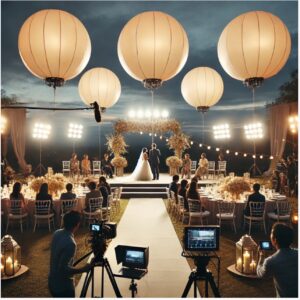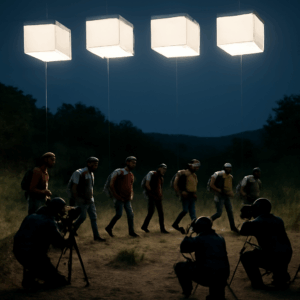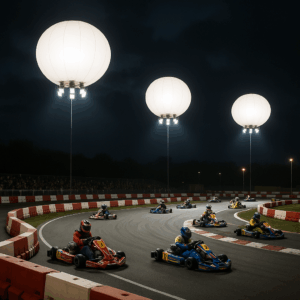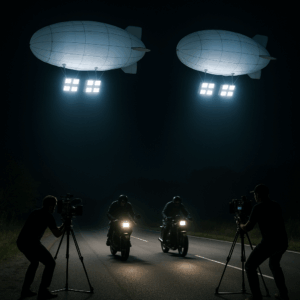In the dynamic world of film and television production, lighting remains one of the most critical components in achieving cinematic excellence. As visual storytelling demands evolve and production environments become increasingly complex, filmmakers are actively seeking lighting solutions that offer flexibility, efficiency, and creative freedom. One such innovation leading the next generation of film lighting is the helium balloon LED light — a system that quite literally elevates lighting to new heights.
I. The Evolution of Film Lighting Technology
Film lighting has come a long way since the days of tungsten and HMI fixtures. While these traditional tools remain useful in certain applications, they come with significant limitations — high power consumption, substantial heat output, and a lack of mobility. The introduction of LED technology addressed many of these issues, offering lower power draw and longer lifespans. However, fixed LED panels and fixtures still present challenges in achieving large-area soft lighting without cumbersome rigs or extensive modifier setups.
With the growing demands of on-location shoots, drone cinematography, and high-efficiency production workflows, the film industry needed something more adaptive. Helium balloon LED systems emerged as a revolutionary response, combining state-of-the-art LED arrays with an aerial, helium-inflated structure that redefines the relationship between light and space on a film set.
II. What Are Helium Balloon LED Lights?
Helium balloon LED lights are an aerial lighting system consisting of a lightweight, inflatable balloon — typically made from high-strength, heat-resistant synthetic film — filled with helium gas. Encased within or attached to the structure are high-efficiency LED modules that emit soft, diffused illumination over a wide area.
The balloon shape varies based on the desired lighting effect. Common formats include:
Most helium balloon LEDs are equipped with bi-color (e.g., 2700K–6500K) or RGBWW LEDs, with onboard or DMX-controlled dimming systems, enabling precise control of color temperature and brightness. Designed for fast deployment, they require minimal rigging and can be floated above sets or tethered at specific heights using telescopic stands, winches, or cranes.
III. Advantages Over Conventional Lighting Systems
One of the defining characteristics of helium balloon LEDs is their 360-degree omnidirectional illumination, which produces a soft, uniform glow. This effect is highly desirable for simulating natural moonlight or creating ambient lighting that wraps around subjects without harsh shadows or hot spots. Unlike traditional sources, there’s no need for additional softboxes, silks, or diffusion frames.
2. Lightweight and Easily Deployable
Helium balloon lights are designed to be highly portable and easy to set up. Weighing considerably less than conventional lighting fixtures and their associated modifiers, they can be quickly inflated and deployed by a small team. This reduces setup time, labor costs, and logistical challenges — especially in remote or difficult-to-access locations.
3. Height and Angle Versatility
Floating lighting above a scene was traditionally the domain of large cranes or elevated grid systems. Helium balloons solve this creatively and cost-effectively by enabling vertical flexibility without complex infrastructure. Whether tethered at 5 meters for a close-up or elevated to 25 meters for a wide aerial shot, balloon LEDs provide consistent lighting coverage from any angle.
4. Energy Efficiency
Modern balloon lights utilize high-efficiency LED chips with luminous efficacy often exceeding 150 lm/W. This significantly reduces power draw compared to HMIs or tungsten sources, allowing them to run on standard AC power, generators, or even battery systems. Lower heat output also enhances on-set safety and reduces cooling requirements.
IV. Applications in Film and Television Production
Helium balloon LEDs are most frequently deployed for night exterior scenes, where they function as a naturalistic source of moonlight or ambient fill. Their soft glow mimics the real sky, adding dimension and realism to outdoor sequences without overexposing highlights or creating hard-edged shadows. When elevated above the action, they deliver day-for-night compatibility by providing even ambient lighting that can be color-graded in post-production.
2. Interior Set Illumination
On studio sets, balloon lights offer a clean and unobtrusive lighting solution. Suspended from the ceiling or floated above a scene, they free up valuable floor space and minimize clutter, enhancing safety and allowing unrestricted camera movement. Their 360-degree light coverage minimizes the need for multiple fixtures and reduces the risk of boom shadows or gear reflections.
3. Mobile and Guerrilla Filmmaking
In fast-paced or unpredictable shooting environments, such as car chases, outdoor camping scenes, or documentary field work, helium balloon LEDs excel in quick deployment and adaptability. Lightweight and self-contained, they allow small crews to move from setup to setup efficiently without heavy rigging or generator packs.
4. Visual Effects and Green Screen
Helium balloon lights are also ideal for visual effects (VFX) shoots and chroma key setups, where consistent, diffuse lighting is essential to avoid shadows and spill. Their broad coverage simplifies background replacement and compositing, enabling cleaner keying and more convincing integration of CGI elements.
V. Case Studies and Industry Adoption
Major productions, both in Hollywood and internationally, have already adopted helium balloon LED systems. From epic historical dramas to indie sci-fi films, cinematographers have praised these tools for their:
Studios and rental houses are beginning to include helium balloon systems as part of their core lighting kits, recognizing their growing demand across commercial, narrative, and reality TV projects. High-profile productions have used these lights to achieve dramatic, ethereal lighting effects that would have previously required significant rigging and budget.
VI. Technical and Creative Flexibility
Most helium balloon LED systems come with adjustable color temperature (bi-color or RGBWW), allowing DPs and gaffers to fine-tune the mood of a scene. Integration with DMX512, wireless remotes, and even app-based controls ensures real-time adjustability and seamless integration into modern lighting ecosystems.
Manufacturers now offer a wide range of customizable balloon formats tailored to specific shooting needs. Whether it’s a compact 60cm sphere for tabletop commercials or a massive 2-meter globe for wide aerial setups, the ability to adapt the lighting form factor enhances creative expression.
2. Silent Operation
Unlike many traditional lights that require fans or emit buzzing sounds, helium balloon LEDs operate completely silently. This is crucial for sync-sound shooting and intimate dialogue scenes, where even minor background noise can compromise audio quality.
VII. Overcoming Challenges
Despite their many advantages, helium balloon LED systems do present a few operational considerations:
Manufacturers often offer hands-on support, documentation, and training videos to help crews integrate balloon systems safely and effectively into their workflows.
VIII. Sustainability and Future Potential
With increasing pressure on the film industry to adopt sustainable practices, helium balloon LED systems offer several environmental advantages:
Looking ahead, the integration of solar-powered charging stations, modular battery systems, and autonomous flight control (for drone-mounted lighting balloons) may further enhance the sustainability and versatility of these systems. They also show significant promise in virtual production environments, where consistent lighting across LED volumes is essential.
IX. Conclusion
Helium balloon LED lighting represents a major advancement in film lighting technology. By combining soft, high-quality illumination with mobility, versatility, and efficiency, these systems are revolutionizing the way productions approach lighting design — particularly in challenging or dynamic environments.
Whether you’re shooting a period drama under moonlight, lighting a green screen with zero shadow interference, or needing fast setup times in remote locations, helium balloon LEDs deliver unmatched performance. They reduce crew fatigue, minimize setup complexity, and open the door to new creative possibilities.
As filmmakers continue to push visual boundaries, tools like helium balloon lights are not just a luxury — they are fast becoming a necessity for modern cinematic storytelling.
–The End–
Get in touch for free lighting customization